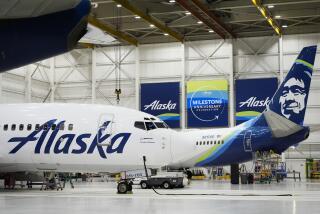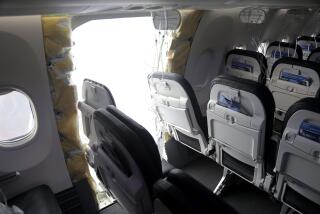FAA OKs Alaska Plan to Improve Maintenance
The Federal Aviation Administration backed away Thursday from a threat to shut down maintenance operations at Alaska Airlines but said problems at the beleaguered carrier are prompting special safety inspections at the nation’s nine other major airlines.
Nick Lacey, the FAA’s director of flight standards service, said Alaska has come up with an acceptable plan to correct “serious breakdowns” that the agency found recently in the carrier’s procedures for ensuring proper repairs and safety.
The deficiencies were uncovered amid growing questions about the carrier’s maintenance after the disastrous crash of Alaska’s Flight 261 in January.
The audits of safety programs at the other big carriers are to begin July 17. The audits should take about four months but are not expected to interfere with flight operations.
“Considering the problems we found at Alaska, we thought it would be prudent to go back and evaluate how the other major airlines are doing in these very same areas,” Lacey told a Washington news conference. “If we find any safety-of-flight issues, we will take immediate action.”
The nine other carriers affected are American, America West, Continental, Delta, Northwest, Southwest, TWA, United and US Airways. Together with Alaska, they account for almost 90% of the air travel in the United States.
Several of the airlines said Thursday that they welcome the audit and would cooperate fully with the FAA.
The FAA threatened June 2 to shut down Alaska’s heavy maintenance operations after a special “white glove” check of procedures that were followed during major repairs on 79 jets.
The FAA did not find that any planes had returned to service in unsafe condition, but it did uncover “serious breakdowns in record keeping, documentation and quality assurance.”
The agency concluded that the airline had improperly deferred repairs on some inoperative aircraft components, defined inspection procedures poorly in maintenance manuals and conducted ineffective audits to detect and correct maintenance shortcomings.
The “root cause” of the airline’s problems, Lacey said, appeared to be ineffective management and “a certain amount of sloppiness.”
The FAA gave Alaska a month to come up with adequate corrective measures or face the loss of authorization to perform heavy maintenance. And that, in turn, could take planes out of service.
Alaska’s plan, Lacey said, “looks good.”
The FAA said the airline intends to add about 130 mechanics to its present roster of about 900. More than 80 already have been hired.
The company’s general maintenance manual has been revised.
A new executive-level safety position has been created, and the top ranks have been reorganized. The vacant positions of director of maintenance and director of operations have been filled.
The airline has developed a new oversight system designed to detect and correct maintenance deficiencies and to improve the safety program.
“We are very pleased that the FAA has accepted our plan,” Alaska’s CEO, John F. Kelly, said in Seattle. “We really tried to go above and beyond what they asked for.”
The FAA has been accused in the past of lax oversight and an unhealthy coziness with airlines it inspects and regulates.
The agency took no punitive action against Alaska, but issued a warning in tough language.
“While we are not taking away Alaska’s authority to perform heavy maintenance today, we will not hesitate to do so--or take stronger action, if the facts warrant--if we are not satisfied with the carrier’s implementation of its plan at the end of 30 days,” Lacey said. “Ninety days after that, we’ll reverify. Then we’ll come back six months after that.”
Six new FAA inspectors will be added to the 12 now overseeing Alaska’s maintenance operations. “Basically,” Lacey said, “we will have an FAA inspector watching each aircraft as it comes out of the maintenance facility.” Several federal safety officials declined comment on Lacey’s remarks. But Jim Burnett, a former chairman of the National Transportation Safety Board, said that in backing away from its initial threats, “The FAA already has hesitated. . . .”
“The FAA only seems to find a problem after a major accident, instead of before, when they might have prevented it,” Burnett said. “And the consequences for the company seem minimal.”
Concerns about repair procedures at Alaska first surfaced in 1998, when a federal grand jury in San Francisco began looking into allegations that records had been falsified at the carrier’s repair facility in Oakland.
Then, on Jan. 31, Flight 261 crashed off the Ventura coast near Anacapa Island, killing all 88 on board.
The NTSB, which is investigating the crash, has focused on the plane’s horizontal stabilizer, which largely controls the pitch of the nose. The pilots reported problems with the stabilizer before the crash.
Questions about the maintenance of the plane arose when investigators found no grease on the stabilizer’s actuator, which was recovered from the wreckage.
The federal probes spread to Seattle six weeks after the crash, when 64 mechanics there signed a letter to the company, alleging that a supervisor had pressured them into substandard work. Later, some mechanics told The Times that several jets had been returned to service despite concerns that further repairs might be needed. The allegations did not involve the plane that crashed.
More to Read
Sign up for Essential California
The most important California stories and recommendations in your inbox every morning.
You may occasionally receive promotional content from the Los Angeles Times.










